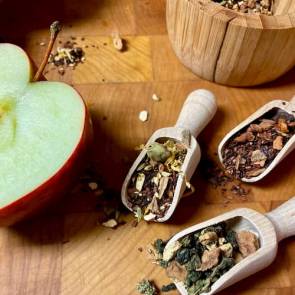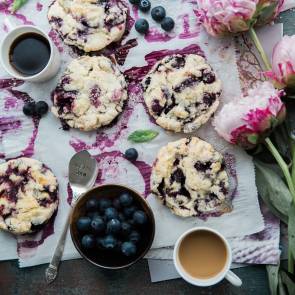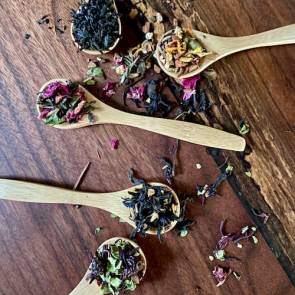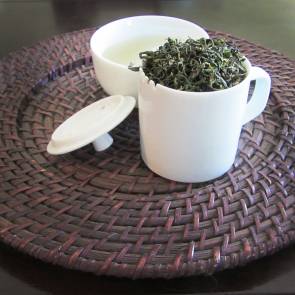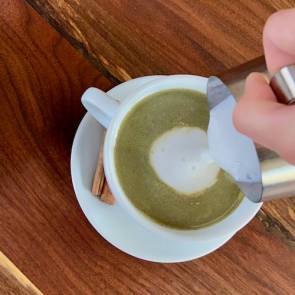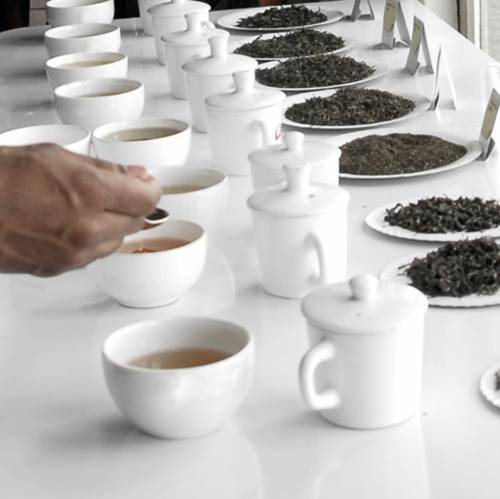
Before we buy a new lot of teas at Shanti Tea, we always perform a proper tea tasting. We line up the same tea from different regions (or similar teas) and taste each one to find the best lot. When you are tasting at home, you probably don’t want to sit and taste the same tea multiple times. There are usually very few noticeable differences from one estate to another if they are trying to produce the same tea.
We've compiled some of the basic information to get started tasting tea at home. Contuct your own tastings, or invite some friends to taste with you!
Theme
- To do you own at home tea tasting, first decide on a theme. This doesn’t have to be anything too detailed. You can choose something like green teas, or Chinese teas.
-
We typically recommend not trying flavoured teas or tea blends for tastings, but you are certainly welcome to!
- The reason we suggest choosing straight teas is two part:
- blends may contain ingredients which will mask the flavours of the other blends,
- tastings are typically done to find subtle differences in tea, or to learn more about the tea. Scroll to the bottom of the page to see a few different themes
- If you intend to use tea blends for your tea tasting, try to be careful with the scale of flavours. For example, Peppermint will overwhelm your palate, as will chai and citrus flavours. If you choose any of these, we suggest you stick to similarly flavoured teas (example, have a minty theme, or citrus fruits, or a chai tasting).
Selection
- Once you have determined a theme, you can now start selecting teas. See the bottom of the page for some ideas.
- Some things to consider when selecting teas:
- Where is the tea grown?
- What types of flavour do you typically enjoy? Some examples: sweet, smoky, grassy, etc.
- What are some teas that you have never tried? You don't have to stick with favourites, use this as an opportunity to try teas that you haven't tried before.
- What will work well together? For example, if you are tasting teas from China, would you include a heavy smoked tea like Lapsang Souchong? If so, then perhaps you may opt not to taste mainly delicate green and white teas, with one intense tea like Lapsang.
- Do not choose too many teas. It can overwhelm the palate. We suggest 4-6 teas.
Tasting order
- Now that you have your teas selected, determine the order teas will be tasted.
- Choose your lightest teas first. It is likely that the company you purchased the teas from offered tasting notes. Use these to help you determine which teas are tasted first.
- Teas with low astringency should be tasted before teas with a higher astringency.
- If you are tasting different varieties, a safe rule of thumb is white teas first, then green, yellow tea, light oolongs, dark oolongs, black tea, pu-erh. Note, you may find that this does not work for all teas. Example, a really light black tea like Darjeeling Black should be tasted before a dark oolong like Wuyi Rock.
- Group teas by flavour profile. If you are doing a tasting of green teas, taste your light, fruity greens first, then grassy, vegetal greens, then smoky greens.
Set up
-
Not everyone has the right equipment for a tea tasting at home! Typically, there will be a vessel to infuse the tea, a bowl to show the dry tea leaves and a cup for the liquid infusion. You don’t have to go out and buy new equipment, here are a few ideas to work with items you likely already have.
- Use small bowls: Put your dry leaf in the bowl, cover with water and infuse. Use a small dish or slotted spoon to cover the top of the bowl and transfer the liquid to another bowl or shallow mug. This way you can keep your wet leaves in the infusion bowl.
- For the cups that will hold the liquor, choose white materials. This is important to see the colour.
- Use disposable t-sacs for the infusion. Once infused, you can cut them open to display the wet leaf.
- Use a small plate for the dry tea leaves. You can also use a small bowl here.
- For the liquid infusion, you can choose to use small bowls, mugs, or any cup of your choosing. Just make sure that it’s heat safe.
- Large spoons. In traditional tea tastings, each attendee will have a large spoon to scoop some liquid infusion from the bowl on display and taste it. You can also choose to give each attendee a small cup or mug, which they can reuse for each different tea.
- A rinse station: If you’re doing this at home, it will likely be your sink. But if you are not near a sink, leave a large pail for people to dispose of liquid infusions (or to spit in!)
- A tea timer! You need to make sure your timing is exact. Use a tea timer to be on the safe side.
- Tea note cards: You may want to make a few notes about the tea to leave near each one. Some bits of information may include country of origin, growing region, growing elevation, time of harvest, harvest method, processing method, etc.. You may also want to include the name of the supplier you purchased the tea from, in case your attendees wish to buy some for themselves.
A short guide
- Now that you have your teas and are set up, here are a few things to keep in mind:
- Pay close attention to the infusion time and temperature of each tea. This is really important. You do not want to burn the leaves.
- If you do not have a kettle that displays temperature, we suggest using a thermometer to check the temperature for accuracy. Otherwise, heat the water until bubbles just start to form for white, green and oolong teas.
- Ask your attendees to bring a pen and paper or provide some for everyone.
- Feel free to use more tea and infuse for a shorter amount of time. This way you can get a good sense of the flavour without risking any bitterness.
- Decide whether you want to try multiple infusions of each or not. Green teas and oolongs lend especially well to multiple infusions. If you decide to incorporate multiple infusions into your tasting, we suggest using only 2-4 teas instead of 4-6.
- Traditionally, during a tea tasting you will hear people slurping and spitting a lot. This is the best way to taste tea, but it’s not the most pleasant auditory experience. Decide whether you want to encourage attendees to use this format. It could be fun!
Why slurp and spit? Take a quick sip through pursed lips, the tea will cool down slightly, which is ideal for properly tasting tea (too hot will limit the range of flavours you taste). It is also said that slurping tea adds oxygen to the tea. Oxygenating tea is said to add some more fullness and body to the tea, bringing out subtle differences in flavour. Spitting is done for several reasons, but the primary one being volumes. Those who taste tea for a living would rather not consume huge volumes of tea in one day. Spitting the tea out allows you to get a full sense to the flavours, without having to drink large amounts of tea. It also is said to allow the taster to taste multiple teas side by side without having one influence the taste of another.
The Tasting
Now you’re finally ready to taste!
- Infuse all of your teas according to the guidelines suggested.
-
Leave a sample of the dry leaf, then the wet leaf, and the infusion.
- Examine the dry leaf.
- What does it look like? Is it a whole leaf, broken leaf? What colour is it?
- What does it smell like?
- What does it feel like? Dry and delicate? Springy? Fresh?
-
Examine the wet leaf.
- What does it smell like?
- What does it look like?
- What does it feel like?
-
Examine the liquor.
- What is the colour?
- What does it smell like?
- What does it taste like?
- What does it feel like? The mouthfeel is important when tasting. Creamy, astringent, full bodied, light, cleansing – these are some terms to help describe mouthfeel.
- What is the aftertaste? Some teas have a very pleasant aftertaste. If you are having difficulty noting the aftertaste, try opening your mouth to take in a bit of air after you swallow the tea.
- Does it remind you of anything? A day, time of year, memory, food, beverage or anything else?
Food
We do not recommend food during a tea tasting. If you want to serve food, we suggest that it be served after the tasting is complete. If served before, ensure that the flavour profile is very light and the food will not leave a lingering aftertaste (so no garlic!)
Are you a business owner?
Tea tastings for your business can work in two ways. You can set up tea tastings for your staff to get to learn more about the teas they serve. You can also set up tea tasting events for customers to get to learn more about the product and to connect with your business.
Shanti Tea offers tea tastings! Contact operations@shantitea.ca. We will be happy to come to your business and offer tea tastings for staff or your customers. We also offer training sessions to help teach your staff how to conduct tea tastings themselves (along with many other training sessions).
EXAMPLE THEMES AND TEA SELECTIONS
Please see a few ideas for themes below. The tea suggestions are listed in order, start your tasting with the first tea on the list.


